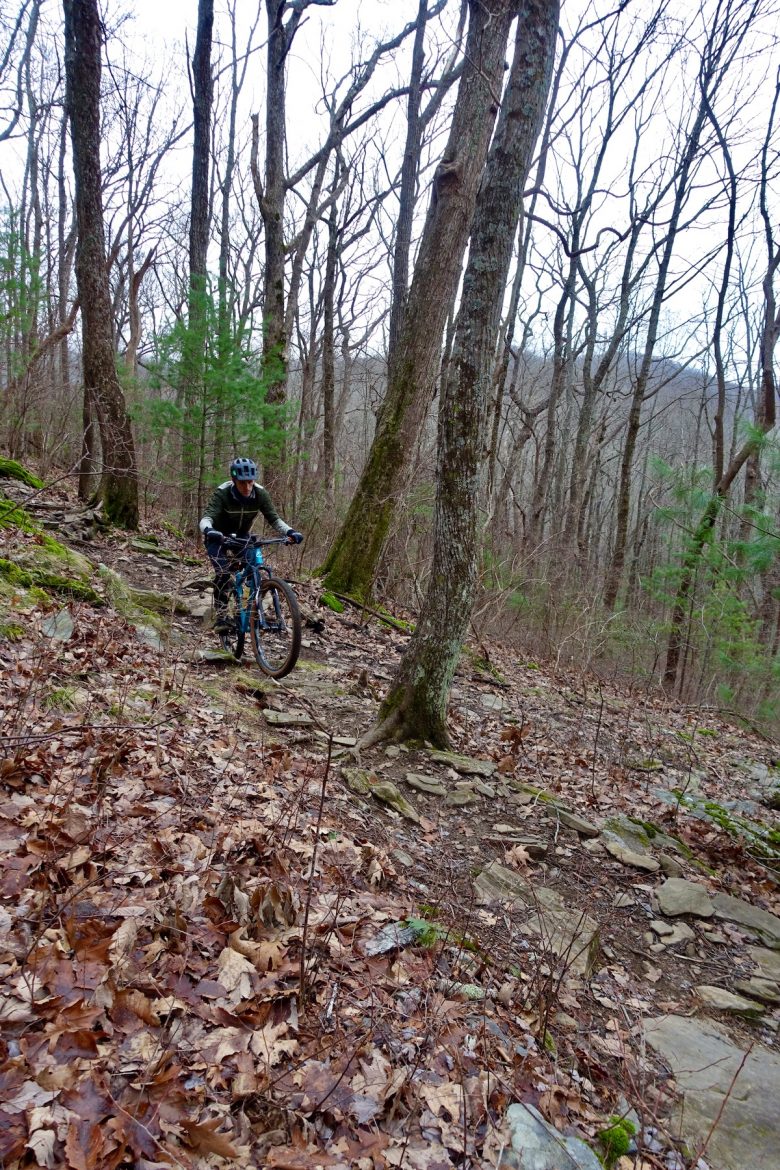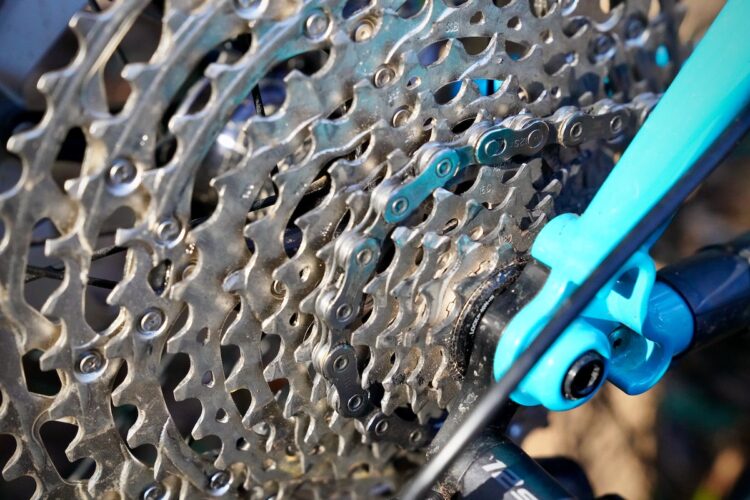
Wheels are probably not the first thing that comes to mind when mountain bikers hear the name Shimano. The brand may not offer the flashiest, bleeding-edge wheelsets, but what they do have is solidly dependable and surprisingly affordable. While testing a couple of the latest drivetrains from the brand, I found myself in need of a compatible set of wheels, so I bolted on this pair of 29er, Shimano XT M8120 wheels to get rolling.
Key specs
Starting at the outside, Shimano XT rims are constructed from aluminum with a 30mm internal width. While these XT wheels sit second-to-the-top of Shimano’s mountain bike wheel line, only their highest-level, XTR-branded wheels get carbon hoops. The XT rims come taped and ready to roll tubeless, and Shimano recommends pairing with 2.25- to 2.6-inch-wide tires.
Both the front and rear wheel feature 28 asymmetrically-drilled spoke holes, and Shimano uses the same 2-cross lacing pattern on the left and right sides of each wheel. My test set uses the same J-bend, round (non-bladed) 2.0-1.8-2.0 double butted spokes front and rear, which should make finding and replacing them pretty straightforward down the line.
The front hub is fairly standard, with a 15mm diameter thru axle, 110mm spacing, and Center Lock rotor mounts.
A Micro Spline driver in the rear is compatible with all of Shimano’s latest 12-speed drivetrains, and it’s designed to fit the tiny 10T cog that lets riders go fast. The 148mm Boost-spaced hub only offers 7° of engagement, though prospective buyers might be willing to overlook that slower engagement considering the pair of wheels is priced under $500.
My set of 29er test wheels, with rotor lock rings and tubeless valves installed, weighs 1,120g for the rear and 960g for the front.
Set up and installation

Although Micro Spline may be new for many riders, the good news is the cassette tool you already have will probably work with your Shimano 12-speed cassette lock ring. It’s easy to line cogs up and slide them in place with the wide key gap on the driver body.
I tested a couple different tubeless tires with these rims and all went on smoothly and easily. The included tubeless valve stems fit tightly and aren’t the flimsy type that threaten to bend or break every time you fiddle with the pressure.
The Micro Spline freehub does essentially tie buyers into the Shimano universe when it comes to drivetrain options. Of course, it’s not a supermax prison, as adapters and workarounds are available, but switching brands will involve a bit of extra work and potential expense when it’s time to upgrade.
On the trail
In fitting with the XT designation, Shimano positions the M8120 as a wheelset for trail bikes, so I mounted mine to an Orange P7 29er hardtail trail bike. Hardtails work great for testing wheels since the feedback is much more direct compared to a full suspension bike. The tires I tested with these wheels ranged from 2.4 to 2.6″ wide.
Pedaling out of the gate, the Shimano XT wheels feel stiff and responsive. There’s little noticeable flex in any direction, whether mashing pedals hard or braking into a turn. While the aluminum rims add a bit of rotational weight over the carbon hoops I had mounted on this bike previously, their ability to accelerate isn’t noticeably lacking thanks to the overall stiffness from the rim through the spokes. Put another way, while on paper it probably takes a bit more energy to get the wheels rolling, drivetrain power seems to be transferred more quickly and efficiently thanks to the overall stiffness of the system.
Of course stiffness isn’t always welcome, especially when it comes to comfort. I found the XT wheels can certainly feel harsh riding rocky and rooty trails, so some riders may find a need to dial down tire pressures to compensate. Beyond comfort, the upside to lower pressures is often better traction and even more efficient rolling, though the tradeoff is the risk of pinch flats and busted rims.

Lately we’ve seen wheel companies introducing wider rim edges as a way to reduce pinch flats. A wider edge (generally around 4mm) is essentially a duller knife that has to work harder to slice through sidewalls when the tire bottoms out. This feature is generally found on carbon rims since manufacturers are able to manipulate the carbon fiber layup to get the right shape.
Shimano lists the outer diameter on the XT rims at 34.7mm, and with a 30mm internal width, that leaves nearly 5mm for the rim bead edges, or about 2.4mm per side. While that may not be as much as the latest carbon fiber rims offer, in my testing it’s been surprisingly kind to tires. On one of my regular riding routes there are two sets of square-edged, granite stones, each spaced roughly 12-18 inches apart, that are true rim bangers. Just thinking about those stones makes me mad when I consider all the flat tires they’ve caused. The good news is I haven’t had a pinch flat on these rims yet (knock on wood) and I suspect the friendly rim edges deserve at least some of the credit.
To be clear, I’ve dinged these rims a lot, through this section of rocks and many others. Some hits were truly sickening. The kind that make you think, “Well, there goes my ride. You go ahead, I’ll be here fixing a flat.” But as I said, I haven’t had any flats, though I was sure I must have damaged the rims. While drafting this review I decided to inspect the rims — particularly in the rear — up close for any dings, scratches, creases, or bends.

Much to my surprise, I couldn’t find any damage from rock strikes, beyond the superficial. Not that I was ever all that concerned; these are, after all, aluminum rims. The only sign of wear so far is where the black finish has been rubbed off along the rim, clearly from rock strikes and also possibly a few sealant-soaked tire changes. According to Shimano, the 8120 rims are painted, whereas previously the 8100-series rims were anodized, which suggests a potentially less durable finish on the latest rims.
After countless hard rides, there are only faint signs of gouging on the freehub body. I often notch pretty deep gouges in driver bodies, probably due to spinning too hard in too low of a gear most of the time, and the XT hubs seem to do a good job resisting the abuse.
With mountain bike hubs on the market today that feature crazy quick, sub 1° engagement, the XT hub loses some of its luster. Offering up to 7° of rotation before the first click, the wheels can and do feel sluggish at times, especially for those used to better engagement. I can’t say that lack of responsiveness prevented me from riding up something I would have otherwise ridden, or screwed up a technical needle-threading I was trying to set up. However, it certainly does negatively affect the overall ride feel, especially once when you’ve experienced a faster-engaging hub.
One thing I always note in wheel reviews is how “buzzy” and loud the freehub sounds when coasting down the trail. These hubs are best described as medium-loud… when they’re making any sound at all.
During my testing I noticed the XT wheels alternate between buzzy and silent, seemingly without any rhyme or reason. I tried spinning the wheel fast vs. slow, on its side vs. perfectly vertical, and on warm days vs. cold. No matter what I tried, or in what order, the buzzing basically just randomly turns itself on and off.
When I mentioned this peculiar behavior to Gerow, he noted he’s experienced the same thing with the XT wheels too. We reached out to Shimano to learn more and aside from being assured this doesn’t affect the performance of the hub, we didn’t get a good explanation for why this happens. Readers, if you can explain, please share in the comments below.
Despite hundreds of pretty hard miles on the Shimano XT wheels, mine are still rolling true and feel like they have a ton of life left in them.
Bottom line
While these aren’t the flashiest, buzziest mountain bike wheels on the market, I’ve found the Shimano XT wheels to be incredibly reliable and dependable. Given the price, availability, and servicability, these wheels are a solid choice for almost any mid-level trail bike build.
MSRP: $419.99 USD. Available at Competitive Cyclist and other online retailers.























